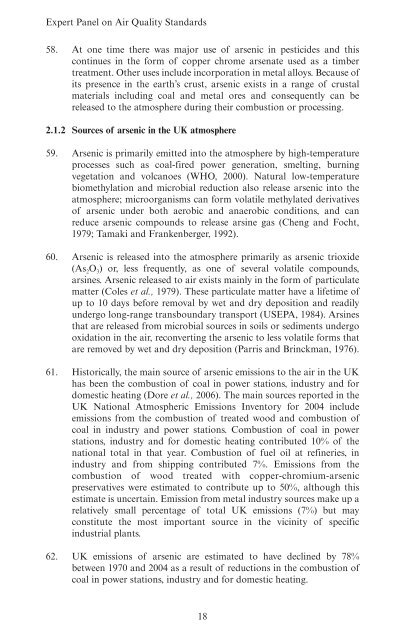Guidelines for Metals and Metalloids in Ambient ... - ARCHIVE: Defra
Guidelines for Metals and Metalloids in Ambient ... - ARCHIVE: Defra
Guidelines for Metals and Metalloids in Ambient ... - ARCHIVE: Defra
Create successful ePaper yourself
Turn your PDF publications into a flip-book with our unique Google optimized e-Paper software.
Expert Panel on Air Quality St<strong>and</strong>ards<br />
58. At one time there was major use of arsenic <strong>in</strong> pesticides <strong>and</strong> this<br />
cont<strong>in</strong>ues <strong>in</strong> the <strong>for</strong>m of copper chrome arsenate used as a timber<br />
treatment. Other uses <strong>in</strong>clude <strong>in</strong>corporation <strong>in</strong> metal alloys. Because of<br />
its presence <strong>in</strong> the earth’s crust, arsenic exists <strong>in</strong> a range of crustal<br />
materials <strong>in</strong>clud<strong>in</strong>g coal <strong>and</strong> metal ores <strong>and</strong> consequently can be<br />
released to the atmosphere dur<strong>in</strong>g their combustion or process<strong>in</strong>g.<br />
2.1.2 Sources of arsenic <strong>in</strong> the UK atmosphere<br />
59. Arsenic is primarily emitted <strong>in</strong>to the atmosphere by high-temperature<br />
processes such as coal-fired power generation, smelt<strong>in</strong>g, burn<strong>in</strong>g<br />
vegetation <strong>and</strong> volcanoes (WHO, 2000). Natural low-temperature<br />
biomethylation <strong>and</strong> microbial reduction also release arsenic <strong>in</strong>to the<br />
atmosphere; microorganisms can <strong>for</strong>m volatile methylated derivatives<br />
of arsenic under both aerobic <strong>and</strong> anaerobic conditions, <strong>and</strong> can<br />
reduce arsenic compounds to release ars<strong>in</strong>e gas (Cheng <strong>and</strong> Focht,<br />
1979; Tamaki <strong>and</strong> Frankenberger, 1992).<br />
60. Arsenic is released <strong>in</strong>to the atmosphere primarily as arsenic trioxide<br />
(As 2 O 3 ) or, less frequently, as one of several volatile compounds,<br />
ars<strong>in</strong>es. Arsenic released to air exists ma<strong>in</strong>ly <strong>in</strong> the <strong>for</strong>m of particulate<br />
matter (Coles et al., 1979). These particulate matter have a lifetime of<br />
up to 10 days be<strong>for</strong>e removal by wet <strong>and</strong> dry deposition <strong>and</strong> readily<br />
undergo long-range transboundary transport (USEPA, 1984). Ars<strong>in</strong>es<br />
that are released from microbial sources <strong>in</strong> soils or sediments undergo<br />
oxidation <strong>in</strong> the air, reconvert<strong>in</strong>g the arsenic to less volatile <strong>for</strong>ms that<br />
are removed by wet <strong>and</strong> dry deposition (Parris <strong>and</strong> Br<strong>in</strong>ckman, 1976).<br />
61. Historically, the ma<strong>in</strong> source of arsenic emissions to the air <strong>in</strong> the UK<br />
has been the combustion of coal <strong>in</strong> power stations, <strong>in</strong>dustry <strong>and</strong> <strong>for</strong><br />
domestic heat<strong>in</strong>g (Dore et al., 2006). The ma<strong>in</strong> sources reported <strong>in</strong> the<br />
UK National Atmospheric Emissions Inventory <strong>for</strong> 2004 <strong>in</strong>clude<br />
emissions from the combustion of treated wood <strong>and</strong> combustion of<br />
coal <strong>in</strong> <strong>in</strong>dustry <strong>and</strong> power stations. Combustion of coal <strong>in</strong> power<br />
stations, <strong>in</strong>dustry <strong>and</strong> <strong>for</strong> domestic heat<strong>in</strong>g contributed 10% of the<br />
national total <strong>in</strong> that year. Combustion of fuel oil at ref<strong>in</strong>eries, <strong>in</strong><br />
<strong>in</strong>dustry <strong>and</strong> from shipp<strong>in</strong>g contributed 7%. Emissions from the<br />
combustion of wood treated with copper-chromium-arsenic<br />
preservatives were estimated to contribute up to 50%, although this<br />
estimate is uncerta<strong>in</strong>. Emission from metal <strong>in</strong>dustry sources make up a<br />
relatively small percentage of total UK emissions (7%) but may<br />
constitute the most important source <strong>in</strong> the vic<strong>in</strong>ity of specific<br />
<strong>in</strong>dustrial plants.<br />
62. UK emissions of arsenic are estimated to have decl<strong>in</strong>ed by 78%<br />
between 1970 <strong>and</strong> 2004 as a result of reductions <strong>in</strong> the combustion of<br />
coal <strong>in</strong> power stations, <strong>in</strong>dustry <strong>and</strong> <strong>for</strong> domestic heat<strong>in</strong>g.<br />
18
















